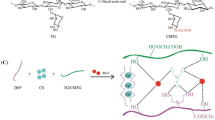Abstract
Being poor solubility and degradation at relatively higher pH present in the small intestine, it is very essential to develop gastro-retentive dosages for the release of curcumin. In this paper, the halloysite nanotubes (HNTs) was modified with aminopropyl trimethoxy silane (APTES) in order to increase the buoyancy of the hybrid beads through holding CO2 molecules within the pores of the beads, followed by the encapsulation of curcumin into the lumen of the HNTs. Highly porous pectin based hybrid beads were fabricated by incorporating various compositions of curcumin loaded amino silanized halloysite nanotube (MHNT) and sodium bicarbonate as CO2 generating agent. Finally, hybrid beads were crosslinked by ionotropic gelation method using calcium chloride and used to gastro retentive delivery of curcumin in sustained manner. The amino salinization of halloysite and curcumin loading into the modified halloysite were characterized by Fourier transform infrared spectroscopy (FTIR), X-ray diffraction (XRD), thermogravimetric analysis (TGA) and transmission electron microscopy (TEM). The highly porous nature of cross-linked hybrid beads has been confirmed with scanning electron microscopy (SEM) studies. In vitro release studies in simulated gastric fluid indicate that these new hybrid floating carriers are suitable for gastro retentive controlled release applications.

Similar content being viewed by others
References
P. R. S. Reddy, K. M. Rao, K. S. V. Rao, Y. Shchipunov, and C.–S. Ha, Macromol. Res., 22, 832 (2014).
H.–J. Hong, J. Kim, Y. J. Suh, D. Kim, K.–M. Roh, and I. Kang, Macromol. Res., 25, 1145 (2017).
C. Bothiraja, V. Kumbhar, A. Pawar, K. Shaikh, and R. Kamble, RSC Adv., 5, 28848 (2015).
E. Deshommes, R. Tardif, M. Edwards, and S. Sauve, Chem. Cent. J., 6, 138 (2012).
G. V. Joshi, B. D. Kevadiya, H. M. Mody, and H. C. Bajaj, J. Polym. Sci., Part A: Polym. Chem., 50, 423 (2012).
L. Shen, C.–C. Liu, C.–Y. An, and H.–F. Ji, Sci. Rep., 6, 20872 (2016).
M. Mahkam, N. Poorgholy, and L. Vakhshouri, Macromol. Res., 17, 709 (2009).
J. Ravindran, S. Prasad, and B. B. Aggarwal, AAPS J., 11, 495 (2009).
M. Bazzano, R. Pisano, J. Brelstaff, M. G. Spillantini, M. Sidryk–Wegrzynowicz, G. Rizza, and M. Sangermano, J. Polym. Sci., Part A: Polym. Chem., 54, 3357 (2016).
E. Abdullayev and Y. Lvov, J. Mater. Chem. B, 1, 2894 (2013).
M. Liu, Y. Zhang, C. Wu, S. Xiong, and C. Zhou, Int. J. Biol. Macromol., 51, 566 (2012).
S. Jana, S. Das, C. Ghosh, A. Maity, and M. Pradhan, Sci. Rep., 5, 8711 (2015).
M. Liu, Y. Chang, J. Yang, Y. You, R. He, T. Chen, and C. Zhou, J. Mater. Chem. B, 4, 2253 (2016).
M. Massaro, S. Riela, P. L. Meo, R. Noto, G. Cavallaro, S. Milioto, and G. Lazzara, J. Mater. Chem. B, 2, 7732 (2014).
G. Cavallaro, G. Lazzara, M. Massaro, S. Milioto, R. Noto, F. Parisi, and S. Riela, J. Phys. Chem. C, 119, 8944 (2015).
K. M. Rao, S. Nagappan, D. J. Seo, and C.–S. Ha, Appl. Clay Sci., 97, 33 (2014).
L. Liu, M. L. Fishman, and K. B. Hicks, Cellulose, 14, 15 (2007).
Y. M. Lvov, D. G. Shchukin, H. Möhwald, and R. R. Price, ACS Nano, 2, 814 (2008).
I. Braccini and S. Pérez, Biomacromolecules, 2, 1089 (2001).
H. Power, M. Karde, N. Mundle, P. Jadav, and K. Mehra, Med. Chem., 4, 588 (2014).
E. Abdullayev, A. Joshi, W. Wei, Y. Zhao, and Y. Lvov, ACS Nano, 6, 7216 (2012).
K. Tazaki, Clays Clay Miner., 53, 224 (2005).
W. O. Yah, A. Takahara, and Y. M. Lvov, J. Am. Chem. Soc., 134, 1853 (2012).
Author information
Authors and Affiliations
Corresponding author
Additional information
Acknowledgments: This research was supported by Basic Science Research Program through the National Research Foundation of Korea (NRF) funded by the Ministry of Education (2017R1D1A1B04032465), and by the 2016 Post-Doc. Development Program of Pusan National University.
Rights and permissions
About this article
Cite this article
Siva Gangi Reddy, N., Madhusudana Rao, K., Park, S.Y. et al. Fabrication of Aminosilanized Halloysite Based Floating Biopolymer Composites for Sustained Gastro Retentive Release of Curcumin. Macromol. Res. 27, 490–496 (2019). https://doi.org/10.1007/s13233-019-7062-z
Received:
Revised:
Accepted:
Published:
Issue Date:
DOI: https://doi.org/10.1007/s13233-019-7062-z




